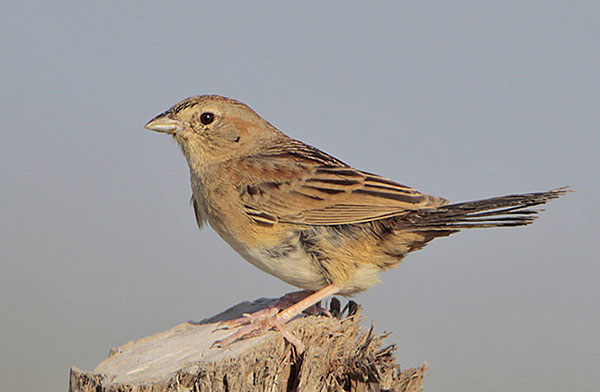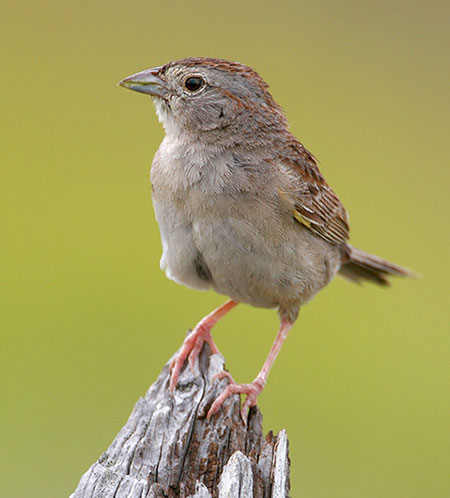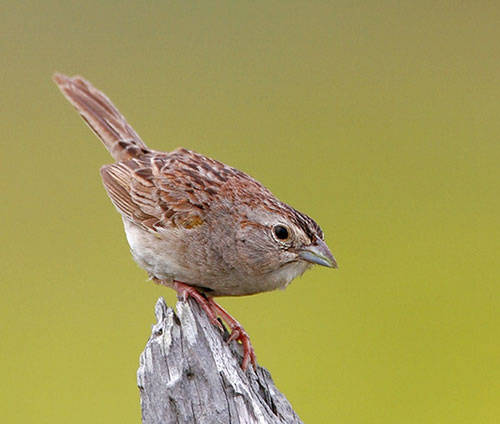The Botteri’s Sparrow is one of many species that is primarily Mexican in distribution, but just reaches parts of the southwestern U.S. While largely resident in Mexico, U.S. populations of Botteri’s Sparrows are thought to be migratory.
A bird of tallgrass habitats, the Botteri’s Sparrow population declined with drought and overgrazing in the southwestern U.S., and conversion of grassland to cropland also made significant impacts on the amount of habitat available.
On this page
Description of the Botteri’s Sparrow
BREEDING MALE
The Botteri’s Sparrow is very nondescript, being mostly brownish with streaked upperparts, a large bill, a flat forehead, and a long tail.

Female
Sexes similar.
Seasonal change in appearance
None,
Juvenile
Juveniles have streaked breasts.
Habitat
Desert grasslands and coastal prairies.
Diet
Insects and seeds.

Photograph © Greg Lavaty
Behavior
Forages from the ground by running or hopping in search of food.
Range
Range: Breeds in limited portions of Texas, New Mexico, and Arizona, and is resident in large portions of Mexico.
Fun Facts
When disturbed on the breeding grounds, Botteri’s Sparrows use an undulating, fluttering flight pattern that may draw attention away from a nest.
Prior to migration, Botteri’s Sparrows begin gathering in flocks.
Vocalizations
The song consists of several high notes followed by a trill.
Similar Species
Cassin’s Sparrows have white outer tail tips and barring on the central tail feathers.
Nesting
The nest is a cup of grass placed on the ground.
Number: 2-5.
Color: White or bluish.
Incubation and fledging:
– Young hatch at an unknown age.
– Young fledge (leave the nest) about 10 days after hatching, but remain with the adults for some time.
Bent Life History of the Botteri’s Sparrow
Published by the Smithsonian Institution between the 1920s and the 1950s, the Bent life history series of monographs provide an often colorful description of the birds of North America. Arthur Cleveland Bent was the lead author for the series. The Bent series is a great resource and often includes quotes from early American Ornithologists, including Audubon, Townsend, Wilson, Sutton and many others.
Bent Life History for the Botteri’s Sparrow – the common name and sub-species reflect the nomenclature in use at the time the description was written.
AIMOPHILA BOTTERII (Sclater)
Botteri’s sparrow is a Mexican bird whose distribution barely reaches into the United States in extreme southern Texas and southeastern Arizona. It was first described by P. L. Sclater in 1857 in the Proceedings of the Zoological Society of London, from a specimen supposedly taken near the Mexican city of Orizaba, state of Veracruz, by Matteo Botteri, a Dalinatian botanist and traveler. Although C. B. R. Kennerly collected a specimen in 1855 at Nogales, presumably in the Mexican state of Sonora close to the border of Arizona, the species was not admitted to the United States list until 1873 and 1874, when the noted pioneer ornithologist H. W. Henshaw collected 14 specimens in the vicinities of Camp (Fort) Grant, Camp Crittenden (near Sonoita), and Cienega (near Tucson) in the Territory of Arizona. Since these early times Botteri’s sparrow has claimed little attention and, until just a few years ago, little was known of of its occurrence in Arizona and Texas, to say nothing of its range in Mexico. Present knowledge of the species’ range, both as to season and locality, still is fragmentary at best. At least in Arizona and Texas it is known to be migratory.
According to the A. 0. U. Check-List (1957) the Arizona and Texas populations of Botteri’s sparrow consist of different subspecies, botterii and texana. Additional subspecies occur in Mexico. Some students, notably J. Dan Webster (1959), regard the so-called Peten or yellow-carpalled sparrow (Aimophila petenica) as being conspecific with Botteri’s sparrow. Webster classifies the form of Arizona and Northwestern Mexico as Aimophila botterii arizonae (Ridgway). To avoid confusion, the present discussion disregards those forms assigned by some authors to A. petenica, or those subspecies formerly regarded as belonging to A. petenica, whichever the case may be. It might fittingly be added that the differences of opinion arising from the problems of classifying Botteri’s sparrow are typical of other perplexities encountered in studying the species. Much of this, naturally, is due to its secretiveness and from the difficulty of identifying it either in the field or in the hand.
There is nearly universal agreement that Botteri’s sparrow throughout its range requires grassland, with at least a scattering of brush or small trees. In Arizona it favors giant sacaton or other tall grasses with mesquite and catclaw (Monson, 1947). In Texas the birds like salt grass (Spartina) with some yucca, prickly pear, and mesquite (Harper, 1930). In its Mexican territory, Botteri’s sparrow prefers open grassland with live oak, as in the Aribabi Hills of Sonora (Marshall, MS.); almost pure grass, grazed moderately to heavily, with an occasional acacia, stone wall, or prickly pear, as in Zacatecas, Durango, and northern Jalisco (Webster, MS.); and palm-dotted savannah, as in coastal Nayarit (Phillips, MS.). Although heavy grass stands are more typical habitat, the species also occurs in heavily grazed grassland near Oaxaca City (Webster, 1959), and in the Sierra de Tamaulipas it has been found in a burned over section (Martin, Robins, and Heed, 1954). Quite a number were noted in Zacatecas in spots where irrigation ditches, grassy pastures, cultivated fields, and acacia mesquite-cactus scrub were in close proximity (Webster, MS.).
Botteri’s sparrow is a terrestrial bird, spending most of its time on the ground where it feeds. It flushes rather readily, and then flies to the nearest bush, fence post, wall or, more rarely, tree. Frequently it drops back into the grass after flying a short distance. In Arizona its associate birds are mainly scaled quails, western kingbirds, ashthroated flycatchers, mockingbirds, eastern meadowlarks, Cassin’s sparrows, and black-throated sparrows; and, in some localities, yellowthroats and blue grosbeaks. Francis Harper (1930) lists its Texas associates as Cassin’s sparrows (especially), long-billed curlews, upland plover, horned larks, eastern meadowlarks, and black-throated sparrows. In Zacatecas, Jalisco, and Durango its commonest associates are: in short-grass plains: red-tailed hawks, prairie falcons, sparrow hawks, horned larks, eastern meadowlarks, and grasshopper sparrows; in open grassland with mesquite-cactus-acacia scrub: Cassin’s kingbirds, horned larks, mockingbirds, curve-billed thrashers, loggerhead shrikes, eastern meadowlarks, brown towhees, and blackchinned sparrows (Webster, MS.). In Nayarit common associates are bobwhites, ground chats, and eastern meadowlarks (Phillips, MS.).
Nesting: Information on the nesting of Botteri’s sparrow is singularly lacking. Gale Monson (1947) pointed out the absence of positive nesting evidence for Arizona, despite the species’ presence in the state from mid-May to early October. The sexual condition of birds collected in the state, even in August, plus two September and October specimens in mostly juvenal plumage suggest that they do nest there.
In Texas the species nests mainly in June, with a nesting density of one nest to each 10 acres on the Laguna Atascosa National Wildlife Refuge (Davis and Gill, 1948).
The few nesting dates I have for Mexico, in regions not adjacent to Arizona and Texas, fall in May, June, and July; none of these appears to be a positive record, however. Birds still partly in juvenal plumage have been taken in Nayarit in November.
No exact information on the type of nest location preferred or on the type of materials used in construction is available. The nest is said to be placed on the ground.
Eggs: Authentic egg data are almost lacking. The species reportedly lays from two to five, usually four unspotted white eggs. They are ovate and have only a slight gloss. The measurements of 28 eggs average 19.8 by 15.2 millimeters; the eggs showing the four extremes measure 21.4 by 16.5, 18.3 by 14.7, and 19.3 by 13.9 millimeters.
Plumages: Adult male: above reddish-brown, the feathers edged with gray; black shaft streaks on the forehead and back; tail dusky with broad brown edgings and tips; bend of wing light yellow; sides of head (including superciliary stripe) and neck dull ash gray; a narrow reddish postocular stripe; chin, throat, and belly whitish; chest, sides, and flanks grayish-buff; maxilla dusky, mandible paler; iris brown; legs and feet very pale brownish buffy or dull straw color.
Adult female: similar to male but with much more extensive black shaft streaking, including the hindneck and crown. Even the flanks are narrowly streaked with blackish.
The following description of the juvenal plumage is quoted from R. R. Graber’s (1955) thesis on the juvenal plumages of Fringillidae:
“Fleshy parts: Bill yellow-flesh color, iris dark brown, feet flesh color; lower mandible yellowish pink, feet yellowish-flesh. Natal down: Pale buffy gray on crown and nape; lighter (whitish) on back, wings, and sides of rump.
Plumage: Feathers of forehead and crown and back blackish, edged with buiffy gray. Nape buffy gray, much less black than crown. Rump mottled buffy and black. Upper tail coverts and median rectrices black, broadly edged with Brussels brown. Other rectrices black. Remiges slate gray (tertials black), primaries edged with gray, tertials with rusty. Tertials margined with buff. Wing coverts black, lessers and medians edged with creamy buff, greaters edged with cinnamon, tipped with buff. Two wingbars. Lores light gray. Superciliary line cream, and most prominent anterior to eye. Eyering cream colored. Side of head uniform huffy gray. Chin and throat cream, with bare suggestion of ‘mustache’ marks. Other under parts cream, belly most richly colored. Chest and flanks tinged with pinkish buff. Jugulum, chest, sides, and flanks streaked with dusky. Belly and crissum unmarked. Leg feathers cream, marked with dusky. Coverts black, medians and greaters broadly tipped with creamy white (two distinct wingbars). Greater coverts narrowly edged with light cinnamon. Lores black. Cream-colored line between bill and eye. Eye ring white. Patch below eye black. Superciliary line obscure except anterior to eye. Auriculars gray. Pattern in malar region as in adult, cream-colored malar stripe outlined in black (subocular region and sides of chin). Chin and throat white, flecked with dusky. Other under parts (except crissum) white, tinged with buff on breast. Breast and sides heavily streaked with dusky. Belly and flanks largely white. Crissum rich orangish buff.”
Food: Little is known of the food habits of Botteri’s sparrow. Clarence Cottam and Phoebe Knappen (1939) analyzed the stomach contents of 2 birds taken in Arizona and 12 from Texas, finding them to be about 86 percent insects, mainly Orthoptera, and about 14 percent seeds of weedy plants and grasses. Joe T. Marshall, Jr. (MS.) found mixed insects and vegetable matter in two stomachs from Sonora and Chiapas, and wholly vegetable matter in a stomach from Chiapas.
Voice: The usual call note is a typical sparrow “chip.” The song, although really distinctive once it has been heard a few times, is rather faint and unmusical. Various interpretations of it have been given, all of them subject to individual auditory impressions. L. Irby Davis (1939) describes it as follows:
It is seldom very musical and consists of such a jumble of notes that it seems almost impossible to fit words to it. It begins with some low, rather disjointed, chipping notes and ends with a series that is rather like that of the Chipping Sparrow, or possibly more like the Texas Sparrow. In the middle there are, characteristically, two louder and clearer notes, reminding one of the middle notes of the Sharpes Seedeater’s song. The two words representing thes& lastmentioned notes will be indicated in quotation marks in the following attempts at describing the song. The usual song may be given as wit-wit-cheeup-cheeup”cheer, cheer”, chee chee che ee e e e. Different individuals have slightly different tones and there are a great variety of slight variations such as, chip-chip-twittertwitter: chitter: “cheep cheep,” we we ee e e e, or wit-chee ee-chee ee: chip-chip: ip: ip: ”chee chee,” wit wit we e e e e. At times the halting preliminary notes will be continued for some time and the latter part of the song (which is the musical part) left off altogether: wit-wit-chee-wit-wit-checit-wit-wit-chee-wit.
Allan R. Phillips (MS.) gives the following interpretation:
“Song of Botteri’s sparrow, typically, starts with two faint ‘t.sips,” then gives two ‘che-liclcs’ very like a horned lark, and goes into a metallic trill (monotone, umnusical, speeding up, very like the end of a rufous-winged or black-chinned sparrow’s song). But the elaborate opening is sometimes not given.”
Henry W. Henshaw (1875) says:
“The song begins with a faint trill, followed by a succession of disjointed syllables, which may be expressed by the syllables cha, chewee, wee, wee, wee, wir, the whole delivered in a rather monotonous, listless manner, and remarkable for little else save iti extreme oddity, it being entirely different from any song I have ever heard.”
Francis Harper (1930) describes the song of Texas birds thus: “The song is composed of clear, sweet notes, slightly canarylike in quality. It is exceedingly variable, and seems to be given scarcely twice alike in succession. It begins in a somewhat halting fashion, gradually increases to a trill, and often winds up with a few notes as slow as those at the beginning. One rendering that I put down goes as follows: psil, psit, psitta, psitta, tseeoo, tseeoo, wit-wit-wit-witwit-wit-t-t-t-t-t-t, tseeoo, wit, wit. The distance at which the song can be heard is probably at least 100, and possibly 200, yards.”
The foregoing descriptions show little agreement, and not only indicate how different the song sounds to different listeners, but also points to a considerable variation in the song itself.
Joe T. Marshall, Jr., records in his field notes from the Aribabi Hills, Sonora, the following song that may be atypical:
“July 13 at the mesa camp this was the most conspicuous species, with at least two males constantly singing, not only in the dawn chorus, but all day at intervals. The song is terrifically loud. When I first heard them at dawn, I thought they were A. earpalis near camp. Later I found that they were loud-mouthed birds at least ~ mile off or more: down in the gully bottom or far up on the next rise. The song contains as a middle portion the entire trill of carpalis, which sounds actually like a field sparrow. It is preceded by some shrill upward inflected sooeeps, and then some faltering pliticks like an Empidonax Julvifrons. Then, after the long trill, there is another sooeep (or seeep). The singing all took place from the top of oaks, usually on small dead twigs, where the bird is in plain view but is so upright and motionless that the bird was actually seen only three times.”
The song is invariably delivered from the top of a tree, bush, or post: never from the ground: and is repeated at leisurely intervals. Both Davis (MS.) and Francis Harper (1930) mention hearing the song given by low-flying birds, but there is no instance of a true flight song being delivered. In the United States the song seems to be given from its arrival until August.
Field marks: This sparrow is very difficult to identify in the field, for it lacks distinctive plumage features. One seeing it for the first time can easily confuse it with other sparrows, particularly Cassin’s, and possibly the rufous: crowned or even the shorter-tailed grasshopper and Henslow’s sparrows. It generally does not associate with any of these but Cassin’s, with which it often shares its nesting range. When in song the males can be separated readily. Otherwise the two species can be distinguished only with difficulty, even in the hand.
Seasonal occurrence: In Texas, Botteri’s sparrows begin to arrive, presumably, in late April and most if not all the breeding birds are on hand by May 15. By the end of September, presumably, most are gone again. Authentic records are almost lacking. In Arizona the birds do not appear until the latter part of May, and depart by September (extreme dates May 17 and October 7). Virtually nothing is known of its breeding occurrence in Mexico. Two August specimens in full juvenal plumage were taken in Michoacan and Guerrero, and a July specimen in the same plumage came from Oaxaca. Central and southern Mexico are presumed to be the species’ winter home. However, confirmatory specimens to enable one to depict the species’ winter and migration ranges even vaguely are woefully few in number, and until more specimens with adequate data are available any delineation is mostly guesswork.
DISTRIBUTION
Range: Soutbeastern Arizona, southern Chihuahua (?), and extreme southern Texas south to southern Mexico. Breeding range and winter range imperfectly known and await clarification by further study.
Migration: Early dates of spring arrival are: Arizona: Huachuca Mountains, May 17; Santa Cruz County, May 23. Texas: Lower Rio Grande Valley, April 9.
Late date of fall departure is: Arizona: Sulphur Springs Valley, October 7.
Egg dates: Authentic egg dates are practically lacking.


